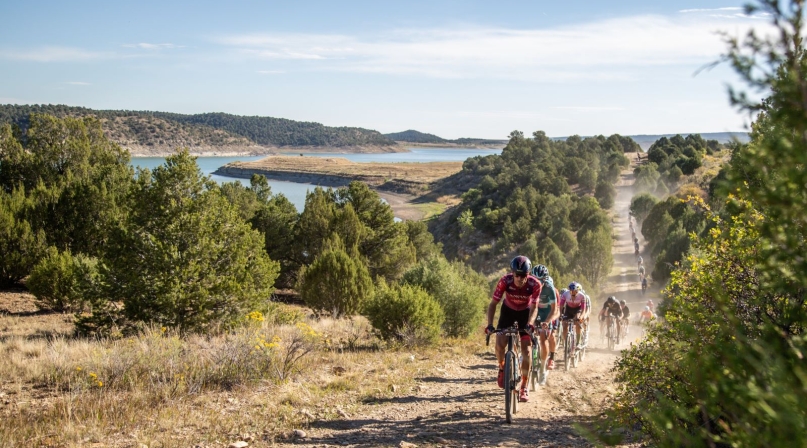Colorado county’s dirt roads shine for cyclists seeking thrills

Key Takeaways
Las Animas County’s roads form the skeleton of the largest county in Colorado. They connect a community fueled by metallurgical coal mining, farming and ranching, but also hold the potential for a new and unexpected economic growth. And they’re not even paved.
Bicyclists have flocked to the county seat of Trinidad over the last three years to ride in the shadow of the Spanish Peaks, and the wheels are moving for outdoor recreation to become a bigger part of the local scene.
Learn more
The Outdoor Recreation Roundtable offers a Rural Economic Development Toolkit
“It is spectacular, both the gravel itself and just the vistas,” said Tamira Jenlink, event director for the last two years of the Rad Dirt Fest. “We can ride courses that are almost entirely off-pavement — that’s what our cyclists want. And 90% of that gravel is some of the best gravel in the state. Just how it’s maintained… the county does an amazing job.”
The natural setting helps.
“It’s fantastic climbing,” she said. You pair it with the scenery and it’s such a stunning combination. You find yourself in some kind of an environment that brings out that pioneering part of you and it’s challenging you to see what’s around that corner. It engages you with how beautiful it is.”
The roads swelled at the end of September with more than 700 people from around the country as they rode 110-, 70- or 40-mile loops. And plenty of family members came with them, some from Austria, South Africa or Switzerland.
“It’s an opportunity to gain exposure and then showcase the magnificent work that our county employees do on the county roads,” said Felix Lopez, chairman of the county commission. “We have two state parks for their families to explore. We have beautiful architecture, and we have a vibrant culture. We might not have a shopping mall, but we’re proud of what we offer.”
The county’s economic model is similar to Lake County, where Jenlink lives and manages 14 Life Time’s cycling and running races and serves as interim president of the Lake County Economic Development Corporation. And the seats of the respective counties offer parallels. The Leadville 100 footrace started in 1983 in response to a mine’s closure, with support from then-Lake County Commissioner Ken Chlouber.
“Trinidad, much like Leadville, has a little bit of that boom and bust,” Jenlink said. “They’ve really been looking for the thing that stabilizes that economy.”
A 2017 study conducted by Colorado Mountain College estimated that the Leadville Race Series brings $15 million annually to the local community. In 2019, the U.S Bureau of Economic Analysis found that outdoor recreation accounted for 3.1% of Colorado’s state gross domestic product, putting the state in the top 20% nationally.
The Headwaters Economics research firm found that recreation counties’ economic benefits include both short-term support for tourism-related businesses and longer-term support by recruiting new residents who may be business owners, entrepreneurs, or workers. It helps boost earnings per job across a community. Those new jobs could include concessioners or small-scale manufacturing that support growing the recreation sector.
“Trinidad could really benefit from that opportunity of something like that, that helps stabilize the economy but also maximizes on the outdoor recreation potential,” she said.
The start in Las Animas County was not promising, though. In 2021, the inaugural event, which drew more than 650 cyclists, coincided with the middle of antelope hunting season. Cyclists also surprised a lot of locals, both on the roads and with some minor private property incursions. When Jenlink joined the race management company in 2022, one of her first priorities was improving the relationship with Las Animas County.
“We had quite a few farming and ranching community members who said, ‘If this keeps going the way it is, we don’t want them around here again,” Lopez said. “Since then, we have had many discussions, many interactions between the community and organizers that have generated a lot of mutual respect and now both can pretty much coexist and thrive on both ends.
“The ride was two days ago, and I haven’t gotten any phone calls from residents. That’s a good sign.”
Lopez appreciates the veritable windfall of attention the county has received from the endurance community — all because the county road and bridge crews do their jobs well.
“We can create a diversified economic exposure in development that most counties are really attempting to do and this happened to us without even going out and hiring a marketing firm,” Lopez said. “I think this could be the birth of a different economy that we were not really planning here in Trinidad.”
While Jenlink is excited to hear the community engagement work has paid off — she made 15 trips to Trinidad from Leadville ahead of this year’s race — she is cautious not to rush in too fast.
“Right now, Lake County is overwhelmed by the events because our infrastructure doesn’t quite match the demand,” she said. “That’s been one of the pieces of working with Trinidad and Las Animas County: Thinking about how we do this so that we don’t get so big before you have the infrastructure in place to handle some of these events — is there enough lodging and capacity? That sends a message to residents that we’re not saying, ‘Suck it up, yeah, we’re going to bring this in because it’s getting us revenue.’ On one hand, that is true, we need to maximize that revenue, but it can be done with a lot of care.
“I think overall, Las Animas County is in a really good position to do that and to empower their businesses and residents to participate.”
Las Animas County is getting into the game on stronger footing than Lake County did, by virtue of not being in the middle of an economic crisis.
Having guided and watched Lake County’s growth as an outdoor event destination grow over 40 years, Chlouber sees potential for Las Animas County thanks to Jenlink’s professionalism and Trinidad’s resources and the open communication the parties are maintaining, including the Las Animas County officials’ openness to the events.
While serving as a Lake County commissioner, Chlouber worked in Leadville’s Climax Molybdenum Mine the day he was told the company was shutting down his site.
“We lost 3,250 jobs that night in a community of 5,000. That was basically everybody,” he said. “We had the highest unemployment in the nation at that time.”
As Chlouber and colleagues brainstormed to combat this crisis with event planning to transition to tourism, Gov. Richard Lamm (D) gave him advice that became his guiding principle.
“He said to get people to spend money in your town, they’ve got to stay overnight,” Chlouber said. “God, that just lit all my candles. I said ‘Well, by golly, if they run 100 miles, they’re damn sure gonna stay overnight.”
Chlouber said Leadville’s endurance races have succeeded for Lake County because they start and finish in town, they didn’t ask local businesses to support them financially and the race managers were not selfish.
“Those first years of the 100-mile run, I ran them every year and I paid my entry fee just like everybody else did, and it worked,” he said.
Lake County’s population has largely stabilized at close to its pre-mine-closure levels, and the success of the events have helped make it a haven for endurance athletes who train in Leadville’s high altitude. Forty years later, that legacy remains part of Chlouber’s life after leaving the county commission and onto the state Legislature and into retirement.
“It’s something I live with every day,” he said.
Related News

U.S. House of Representatives passes SPEED Act and other permitting reform bills
On December 18, the U.S. House of Representatives passed the SPEED Act (H.R. 4776). The SPEED Act would strengthen county involvement in decision-making and make needed commonsense reforms to the federal environmental review process.

Counties and Railroads: Shared Priorities for the Next Surface Transportation Bill
County leaders from across the country have a vital opportunity to ensure their infrastructure priorities are front and center.

Senators introduce bipartisan UPGRADE Act to support small and rural public water systems
On December 15, Sens. Lisa Blunt Rochester (D-Del.) and Roger Wicker (R-Miss.) introduced the Unincorporated Partnerships for Grant Resources, Assistance, and Drinking Water Enhancements (UPGRADE) Act (S. 3465), a bipartisan bill that would strengthen federal support for small public water systems and helps unincorporated communities access clean and affordable water.
